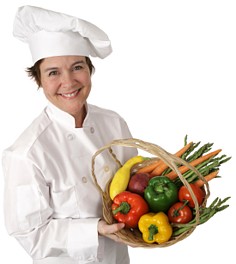Childproofing the Kitchen I
Each room in a house has safety issues that it shares with other rooms, and safety issues unique to its particular function and the way that the household has personalized it. Childproofing the kitchen is an important step every parent should take in making their home safe for children.
Some elements of a kitchen that both raise safety issues and are common to other areas of the home are:
Outlets
- Ground fault circuit interrupters (GFCIs)—The GFCI is a device that limits the risk of severe or fatal electric shock by interrupting the flow of electric current. GFCIs should be used in childproofing the kitchen and bathrooms.
- Electrical outlet safety covers and plates—These products restrict access to electrical outlets, thus reducing the risk of electrocution. They should be installed firmly so that a child cannot remove them and be large enough not to pose a choking hazard.
 Drawers and Cabinets
Drawers and Cabinets
Although it’s always a good idea to latch drawers and cabinets, the products kept in a kitchen—oven cleaner, cleanser, ammonia, carpet cleaner, flea powder, window washing fluid, dish and dishwasher detergent, soap, vitamins, matches, knives, and other sharp implements—require particular caution. When childproofing the kitchen, it is smart to consider re-organizing the cabinets in unexpected ways, such as putting household cleaners that one would normally store under the sink in cabinets up high.
- Safety latches and locks—These devices control access to cabinets and drawers to keep children away from medicine, knives and other utensils, plastic bags, and other dangerous objects and substances.
Sharp Corners and Edges
- Corner and edge bumpers—these protective coverings help prevent a child from being injured from falls against sharp edge of furniture, such as tables or cabinets.
Children can also hit their heads when standing up under a table, so any mechanism under a table, such as a metal lock or runners that are sharp or protruding should also be covered.
Doors
Some kitchens have doors that lead out of the house, and some only have internal doors. In either case, gating the doors may be an important choice to protect a child from parts of the kitchen that cannot be made completely safe, like the oven. Sometimes childproofing the kitchen means restricting access altogether.
- Door knob covers and door locks—These devices help prevent children from entering areas of their home property that are dangerous, while allowing adults to quickly open the door in an emergency.
Sink
A number of babies have enjoyed their first baths in the kitchen or bathroom sink, and whether the child is being placed in the sink, standing on a step stool to wash up, or at the sink for another reason, the area around the sink should be clear of dangerous implements, and protected from the possibility of anything falling on the child. For example, a cabinet or shelf over the sink may have items that can fall. If there is a spray attachment on the kitchen faucet, it should be out of reach.
There is one element that is particular to a kitchen sink: If there is a garbage disposal installed, it should have a protective cover to keep children from encountering the blades. Look for models that are made to run only with the cover on, thus preventing the possibility of accidents.
- Antiscald devices—These regulators for faucets, combined with setting the water heater to a maximum of 120º F (48.88° C) help reduce the chance of children being scalded by hot water. This precautionary step should be one of the first steps in childproofing the kitchen, as well as the bathrooms.
Heat Outlets
If you live in a climate in which indoor heating is used, there will be some means of bringing the heat into the living areas. Whether your home has radiators, forced air vents, or some other heating apparatus, you should take steps to make sure that children cannot burn themselves when the home is being heated.
Written by Mary Elizabeth
Related Home Institute Articles
